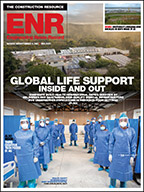Shawn Pressley, PSP, is a civil engineer with 13 years of experience in project management systems and development. As vice president of information technology for construction manager Hill International, Inc., he oversees technology decisions in addition to his other duties with the Marleton, N.J.-based firm. His expertise includes design, planning, implementation and execution of project management software. He also specializes in implementation of financial accounting, CRM, employee relationship management and partner management systems.
Although he's a fan of tablets and their potential to transform construction, Pressley has become wary of jobsites adopting new technology without thinking through their procedures. In this tech Q&A with ENR, he offers some insights about the upside of tablets and pitfalls to avoid. Here are highlights of the chat:
Q: What is the most important tech trend in construction today?
Tablets. You could also say smart phone integration and the iPhone and iPad. They are almost the same thing. Other tablets too from other makers are also part of the trend. Tablets are the biggest trend because it comes down to basic business principles, they are cheaper, faster and more efficient than the pen and paper guys out on a jobsite.
But there is a generation gap [with adoption]. Some guys, the ones in the industry about 30-40 years are not too inclined to use new technology. For folks in their 30s, 40s and younger, this is all they know. They know it's a major game changer. By 2013 and 2014, tablets will be mainstream on jobsites. As a form factor, they are just good and getting better.
The only thing we have to contend with are data plans [for tablets on job sites]. Even though 4G is out, it will be a while before its coverage is saturated enough for major cloud computing applications.
Q: What are the most common activities you're seeing with tablets in construction?
Punchlisting is the most common. But we see a lot of quality assurance and quality control work using them. Also with tracking items: daily report writing, material delivery. These days, with the right apps, you can scan a barcode on materials to find out where it is, do product delivery, and track product delivery. Or check prices on different materials. It's the same as how I use a price-checking feature to find DVDs or other electronics.
Q: What about BIM tools or BIM-in-the-field? Are tablets speeding these along?
BIM is also a methodology for collecting information for the building model. If we can keep feeding information into this model, we will keep expanding its use and innovation.
We're seeing the results using BIM as-builts [on construction sites]. But getting information in to the model is still a hard part. I think you'll see more social media tools merging with BIM, for just the information sharing factor in getting information into models.
Q: What's your take on how fast owners are taking to tablets?
Pressley
Many want to look at the technology and see its potential, but then ask: 'How much more is it going to cost me.' Or, 'I've been doing it this way for a hundred years, why do we need [new technology] now?' The real answer is to build the return on investment argument. With ROI, it's not only what you've gained back with technology; it's what you're reducing in cost.The owners expect you to come up with the technology and figure that out.
Q: What's the downside of the tablet explosion on jobsites?
Teams need to fine-tune their procedures. A lot of people say this is creating efficiencies; but I have to ask: have you ever done this before with a tablet? One thing a lot of people miss [in the rapid pace of adoption] is how technology changes procedures.
You can spend a lot of money customizing programs. But sometimes it's best to customize the procedure. Don't get me wrong. You may need to tweak programs. I've seen hundreds of thousands of dollars dropped on new workflow procedures. The biggest example is the government. You hear time and again: this is our procedure.
It may only be a 10 cent change getting paper out of the equation. But a change in program can be a $10,000 cost. Tablets are making us adopt new procedures. Take the example of documentation on a tablet out on a project. If you have a person using Apple, Windows, how do they get job information from point A to point B? And God forbid something goes wrong. All kinds of questions and procedures come up. How do you get your data? Do we have to print everything out, even if it's 8 gigs of data?
You have to ask: What is your procedure regarding email communications using tablets? How do you capture those? We've gone from a few emails to now sending 50 emails from a jobsite [with these tablets]. How do we deal with that?
E-discovery is becoming a beast [with record-keeping]. So even though the pace is quicker with tablets, it's a flood of information from them. Those are the type of things access and tablets are doing. They can wreak a little havoc, along with the joy of having it done faster. But they are the major trend and will be mainstream by 2013 and 2014.
Q: Especially as firms figure out procedures?
As they figure out procedures, and security of their data.



